BBC Earth newsletter
BBC Earth delivered direct to your inbox
Sign up to receive news, updates and exclusives from BBC Earth and related content from BBC Studios by email.
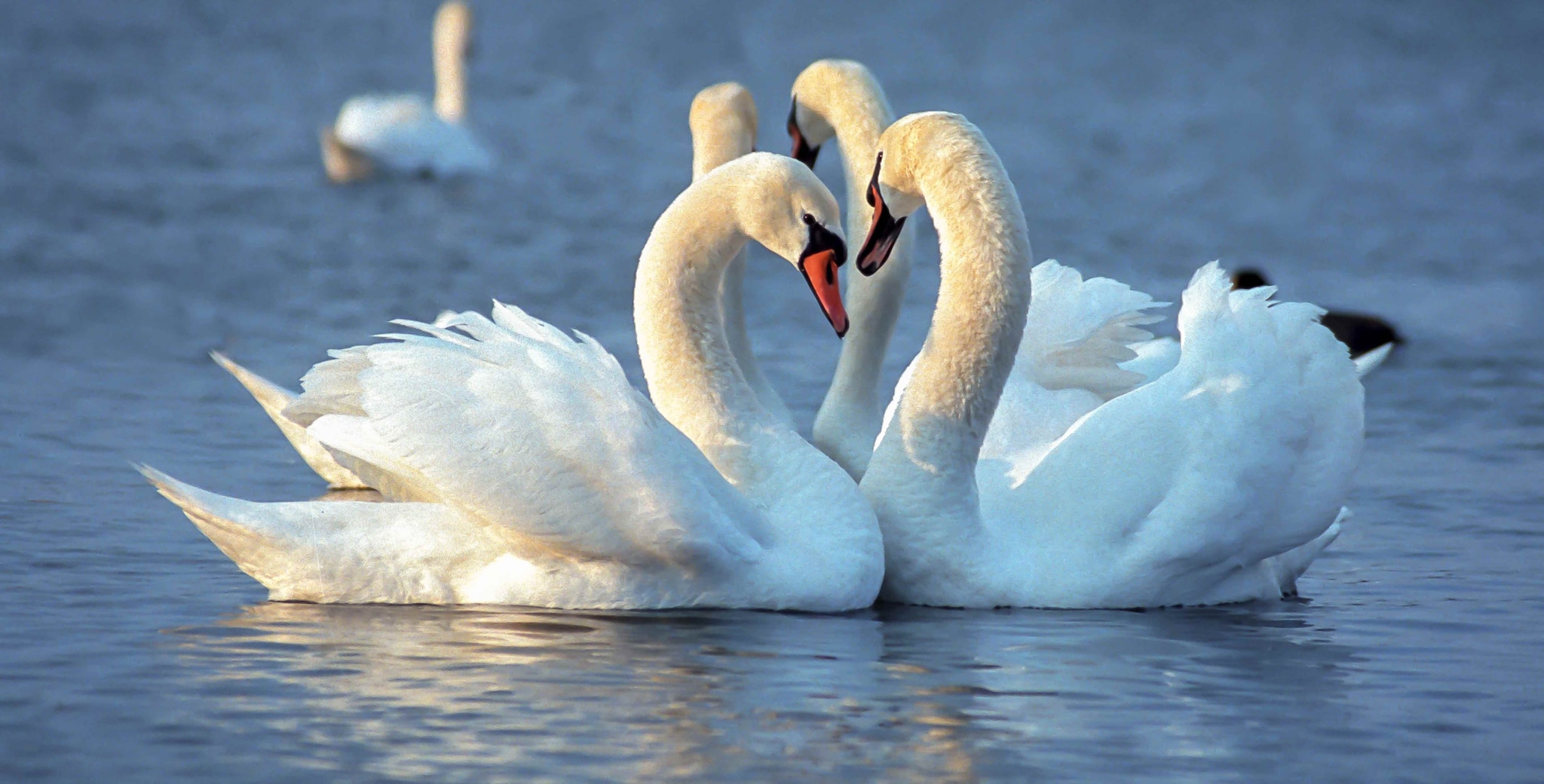
In popular culture, swans are renowned for their beauty, grace and loyalty. But they are also highly territorial, and rather noisy. These large waterfowl are found in wetlands across all continents except Antarctica.
The swan's elegant posture, elongated neck and loyal pairing have endeared it to many cultures across the world. Swans belong to the waterfowl family, along with ducks and geese. They are excellent fliers, and many species migrate across international boundaries to breed. Their leathery, paddle-like feet make them efficient swimmers, although on land many have an awkward waddle. All swan species have distinctive, elongated necks, with mute swans forming an especially exaggerated ’S' shape. Two swans dipping their heads together to form a heart shape is an iconic and romantic image, but their long necks can just as easily lunge forwards to snap at any animal that ventures too close.
Swans are excellent fliers and some of the largest bird species capable of flight. Some species migrate long distances to breed and are among the fastest birds in the waterfowl family. The flight speed of swans can reach up to 96 km (60mph).11 Like many birds, swans have hollow bones to aid flight and buoyancy, and they have fewer bones relative to their size than mammals and reptiles.12 When migrating, swans typically fly in a distinctive V formation at different altitudes; Tundra swans fly at heights of up to 7,925m. For comparison, commercial aircraft generally cruise at 10,000 – 12,000m.13 Swans are also one of the heaviest birds to fly, though the heaviest record-holder is the great bustard.14
A swan has around 25,000 feathers in total, most of which are the tiny ones around its head and neck.15 Their outer feathers, called pennae, are essential for flight; if more than four of these feathers are clipped or damaged, the swan can become grounded. Once a year, swans moult and lose all their flight feathers, grounding them for around six weeks until the feathers regrow.16 While they are capable fliers, swans are unfortunately very accident prone and mid-air collisions with overhead wires, wind turbines and other objects are a major cause of death.17 Other threats include lead poisoning, avian flu, oil spills, illegal hunting and even breaking a hip during crash landings.18
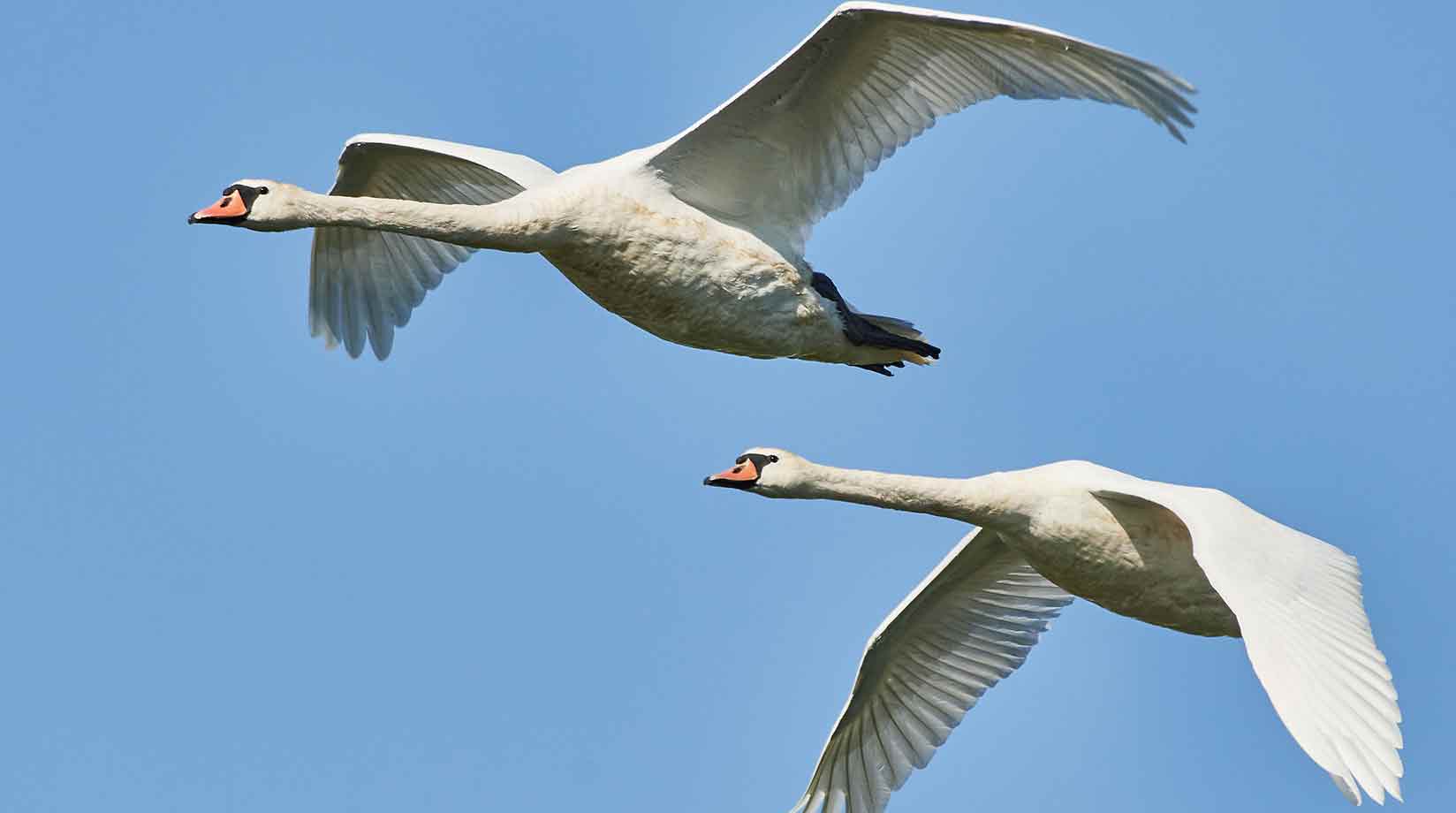
Swans primarily eat aquatic vegetation. They tip their bodies forwards (upend) to plunge their heads and elongated necks underwater to search for food.19
During winter, some swan species eat crops like cereals and potatoes to supplement their diet.20 Swans will also eat small invertebrates, tiny fish, tadpoles, worms, molluscs and small amphibians though vegetation makes up most of their diet. Cygnets eat insects, crustaceans and other small invertebrates for protein.21 If you wanted to feed a swan, you could feed them rolled oats and even bread as long as its fresh (although, you should avoid feeding bread to other bird species), and you should also avoid feeding nesting swans as it can attract vermin.22
Swans do not have teeth, but their bills have serrated edges to filter food from the mud. Like other birds, they have a gizzard (a muscular organ and second part of the stomach) that grinds down hard food like wheat. Swans also use their feet to expose vegetation.23
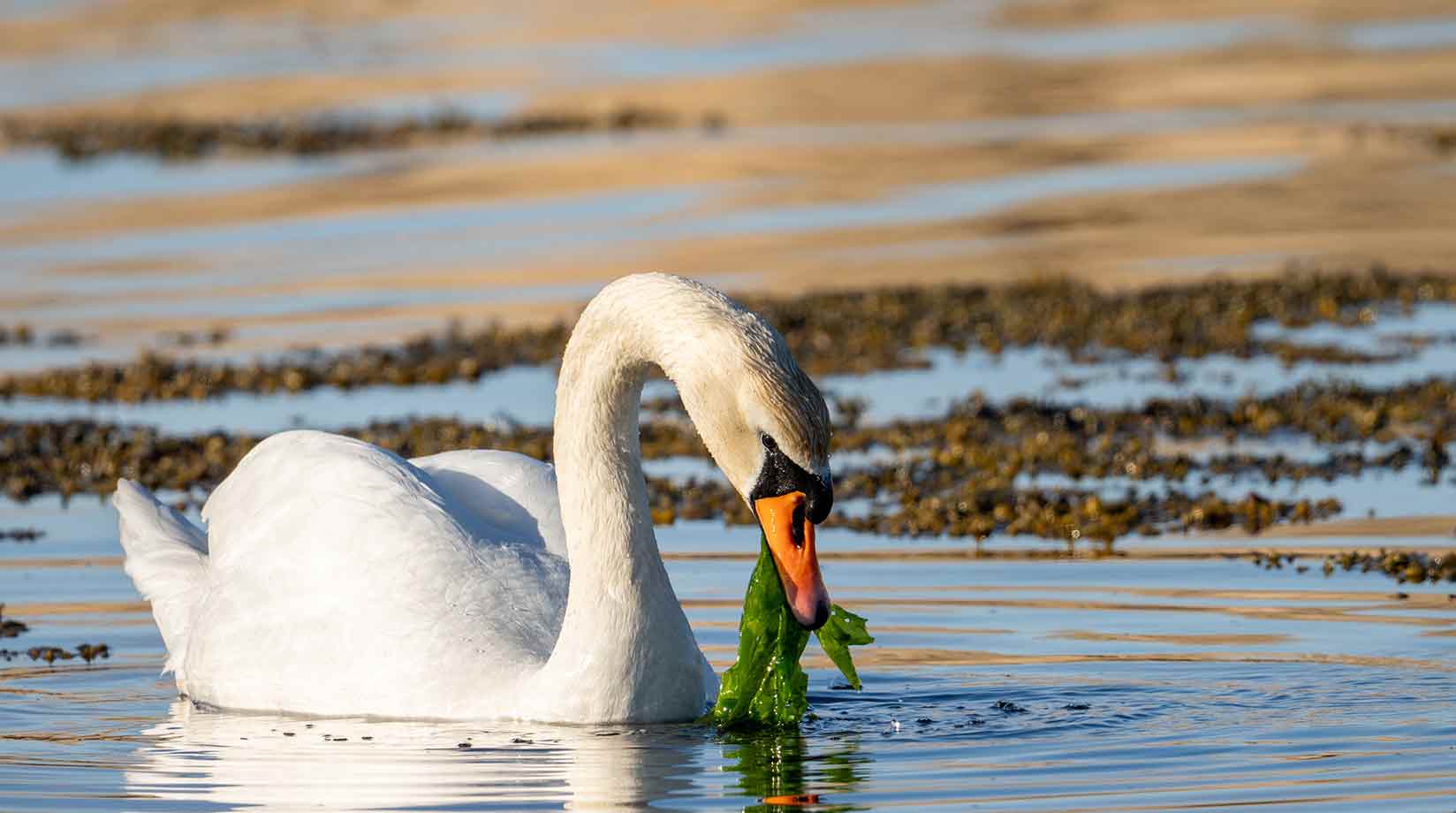
Swans typically drink freshwater but can on occasion drink seawater. Many duck and swan species have a gland near their eyes to extract and remove salt from their blood, which is excreted through holes in the bill called nares.24
Swans usually mate for life and raise multiple broods together.25 They perform unique rituals to identify each other and strengthen their bond. Scientists even think that forming a strong, monogamous bond makes the swan pair better parents, as they are able to learn and improve co-parenting skills together.26 Occasionally, swan pairs may separate, but this is usually after a breeding failure such as unhatched eggs or a destroyed nest. In these instances the bird usually forms another pair, sometimes within six months.27 Black swans are less monogamous: one study found that one in six baby Black swans are fathered by a male outside the swan parental pair.28

Very close bonds are formed between the parental swan pair and their offspring, and cygnets typically stay with the parents for between five and 10 months. However, after this period, the parents often chase their offspring away.29
Swan pair rituals include pre- and post-nuptial displays before and after they mate, as well as some swans performing "triumph ceremonies", where the pair appears to celebrate together after chasing away a threat or winning an aggressive encounter.30 Their rituals can involve swimming in synchrony, dipping their heads into the water, swinging their necks side to side, or bowing heads together to form the iconic heart shape. But not all heart-shaped displays are between pairs; male swans can form the same shape during aggressive stand-offs.31
The idea that a swan can easily break a human’s arm is exaggerated, but it is true that a swan’s wing is capable of causing injury. Swans have very powerful wings; they have a hard carpal bone at the join of their wings which could cause a nasty bruise to a human if they were hit with force by a swan. Young children and elderly people may be more at risk since they have weaker bones. Cases of swans attacking humans are extremely rare, but humans may be most at risk of being injured by a swan which is defending its nest or young. Typically, a swan aims only to chase away, not harm, other swans, geese or threats by beating their wings.32
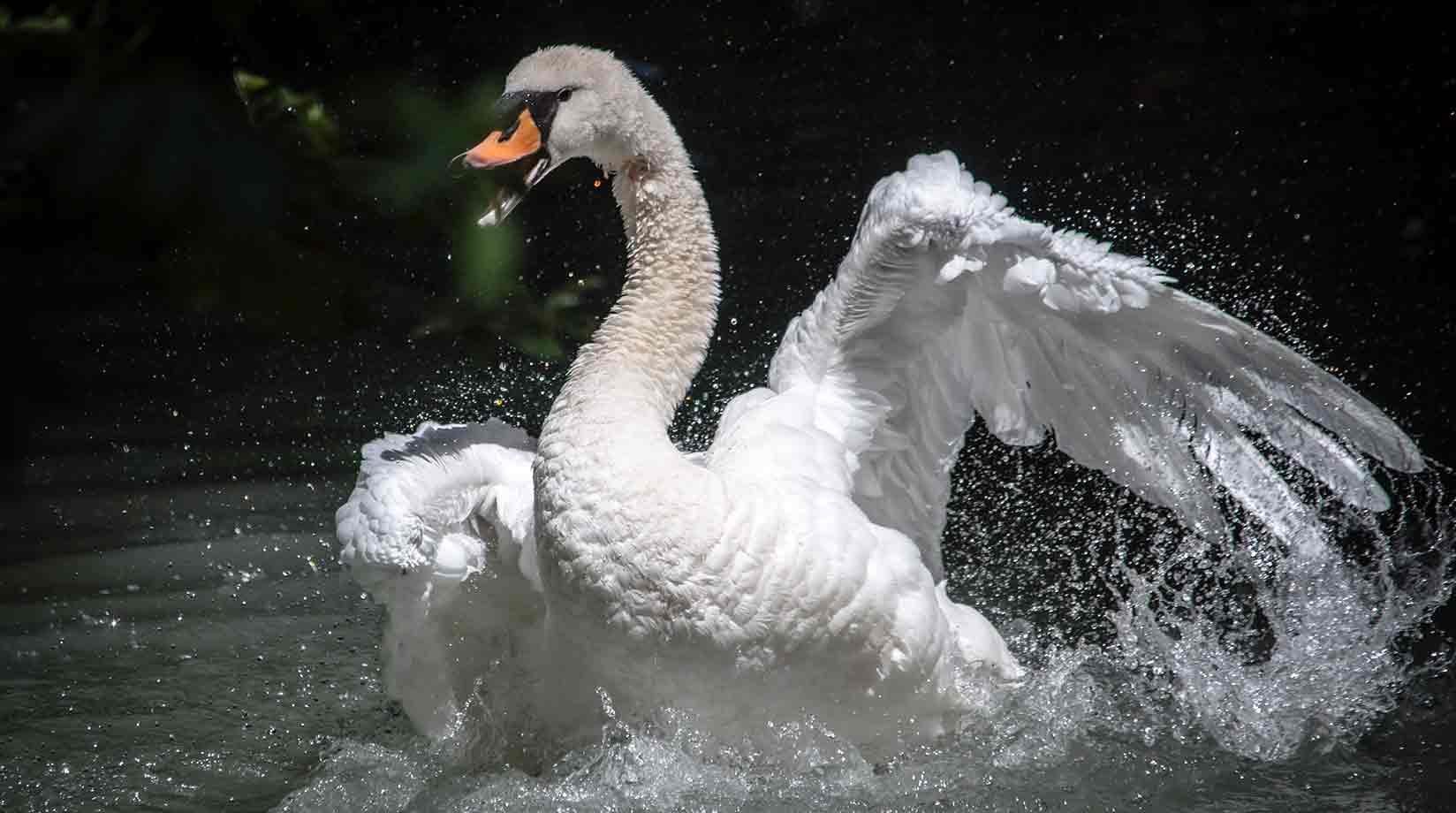
There are six to eight species of swan, depending on how they are classified. The mute swan, whooper swan, trumpeter swan, and tundra swans (Bewick’s swan and the whistling swan) are native to the northern hemisphere. The black swan, black-necked swan and coscoroba swan are native to the southern hemisphere.33 All swans have all-white plumage, except the black and black-necked swans. Beak colours can vary from yellow, orange, black, pink or red, depending on the species.
The whistling swan and Bewick’s swan are often classified as different populations of the tundra swan rather than separate species.34 The whistling swan is native to Eurasia while Bewick’s swan is native to North America. Both are white with black beaks, but Bewick’s swans have a yellow patch at the base of their beak. The mute swan is perhaps the most iconic and recognisable swan species. It has immaculate all-white plumage, an orange beak, upright posture, a dramatically curved neck and a tendency to arch its wings backwards. Mute swans are usually cited as the largest species, at around 1.4-1.6m long and 9.7-11.9kg.35 But trumpeter swans can grow even heavier, reaching up to 14kg.
The coscoroba swan, native to south America, is the smallest species at around 0.9-1.15m. It is no longer considered a true swan in the Cygnus genus and is instead assigned to the genus Coscorba. Scientists found that the coscoroba swan is more closely related to the Cape Barren Goose than to other swan species. It is all-white, has a short neck, a rounded head and a red bill.36
The black swan is not at all rare. Like other species of swan it is classified as Least Concern by the International Union for Conservation of Nature, meaning its population is stable.37 It is native to Australia, where they are widespread, black swans have also been introduced to New Zealand and there are vagrant populations in Papa New Guinea.38 In Australia, the black swan population is estimated to range from 100,000 to 1,000,000 individuals. When swimming, black swans appear completely black, with a red or dark orange beak featuring a distinctive white strip across the tip. Surprisingly, black swans are not entirely black. When in flight, they reveal their white wingtips, which are normally tucked away.39 Before Europeans travelled to Australia, the phrase ‘black swan’ was already used to describe something unbelievable, as only white swans existed in the northern hemisphere.40 When the European explorer Willem de Vlamingh spotted black swans in the late 1600s in Australia, people back in Europe refused to believe the bird existed until de Vlamingh sent specimens back.41 The modern use of the phrase ‘black swan’ often refers to a unprecedented socioeconomic event or natural disaster which cannot be foreseen.42
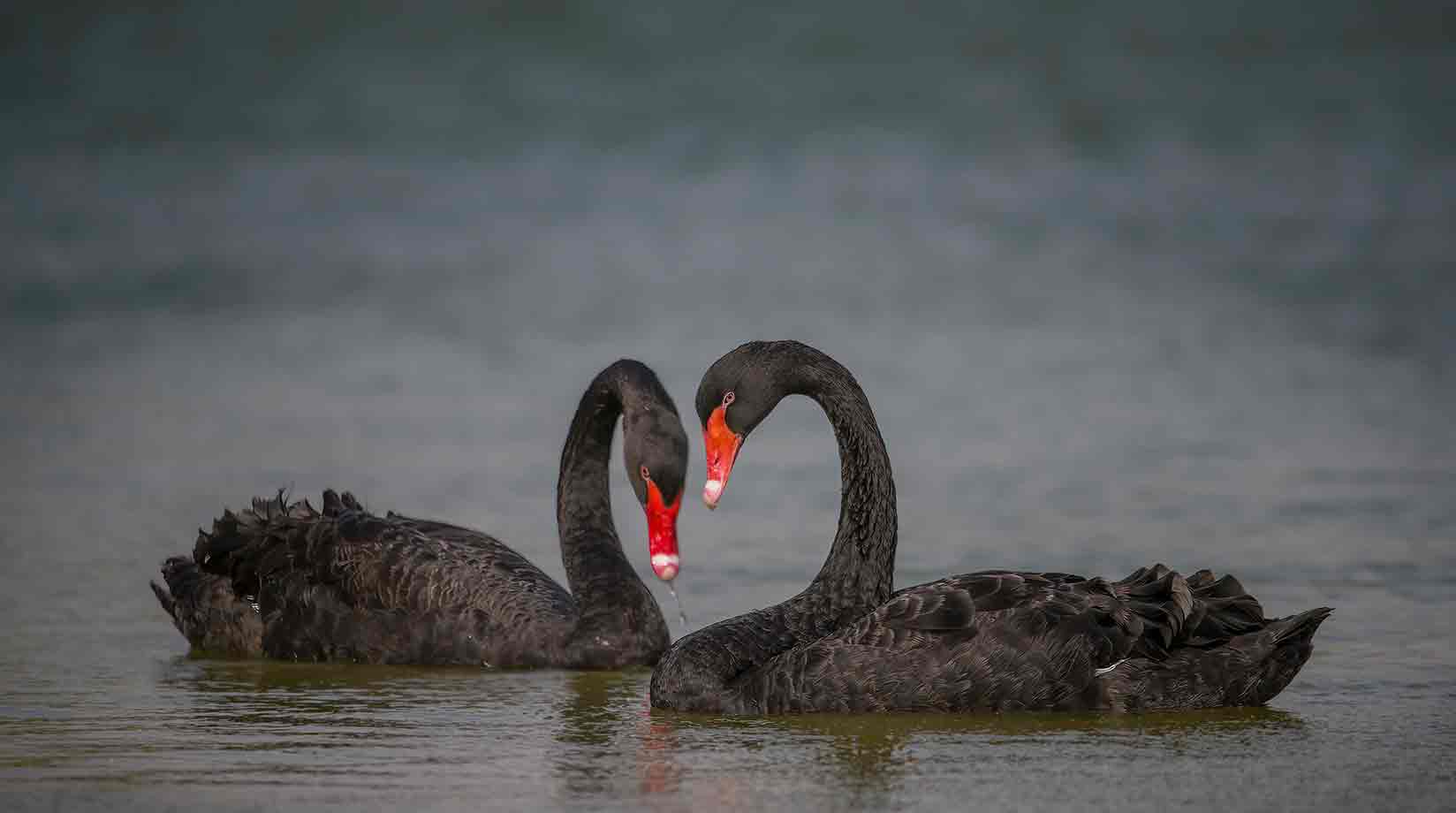
Most swans migrate. They have specific areas, countries or continents where they spend winter, and will typically migrate to different parts of the world during spring and summer to breed. Whooper, tundra and trumpeter swans are fully migratory, travelling long distances between summer and winter breeding grounds.43 Swans can migrate in small flocks and family groups or congregate in flocks of around 300-400.44
Each species has several populations, each with unique breeding grounds and migration routes.45 For example, there are five main populations of whooper swans, all with different migratory paths across Eurasia.46 Swans’ migratory ranges vary extensively depending on species and population group: Tundra swans can migrate for distances up to 6,500 km.47
Mute swans and black-necked swans are partially migratory, meaning only some populations migrate overseas, while others stay in the same area year-round.48 Truly wild populations of this species are migratory (particularly where displaced by cold weather) although European and feral populations are essentially sedentary or only locally migratory.49 Black swans are considered resident birds, meaning they live in Australia and New Zealand and do not migrate, although they have been introduced to Papua New Guinea.50
In autumn, some populations of Bewick’s swan migrate 3,500km from northern Russia to the UK, the Netherlands, Denmark and Germany to escape the harsh Arctic winter, and return to Russia in spring to breed. These journeys are dangerous. There are few wetlands along the way for resting, and the swans are also at risk of flying into power lines or being illegally poached.51
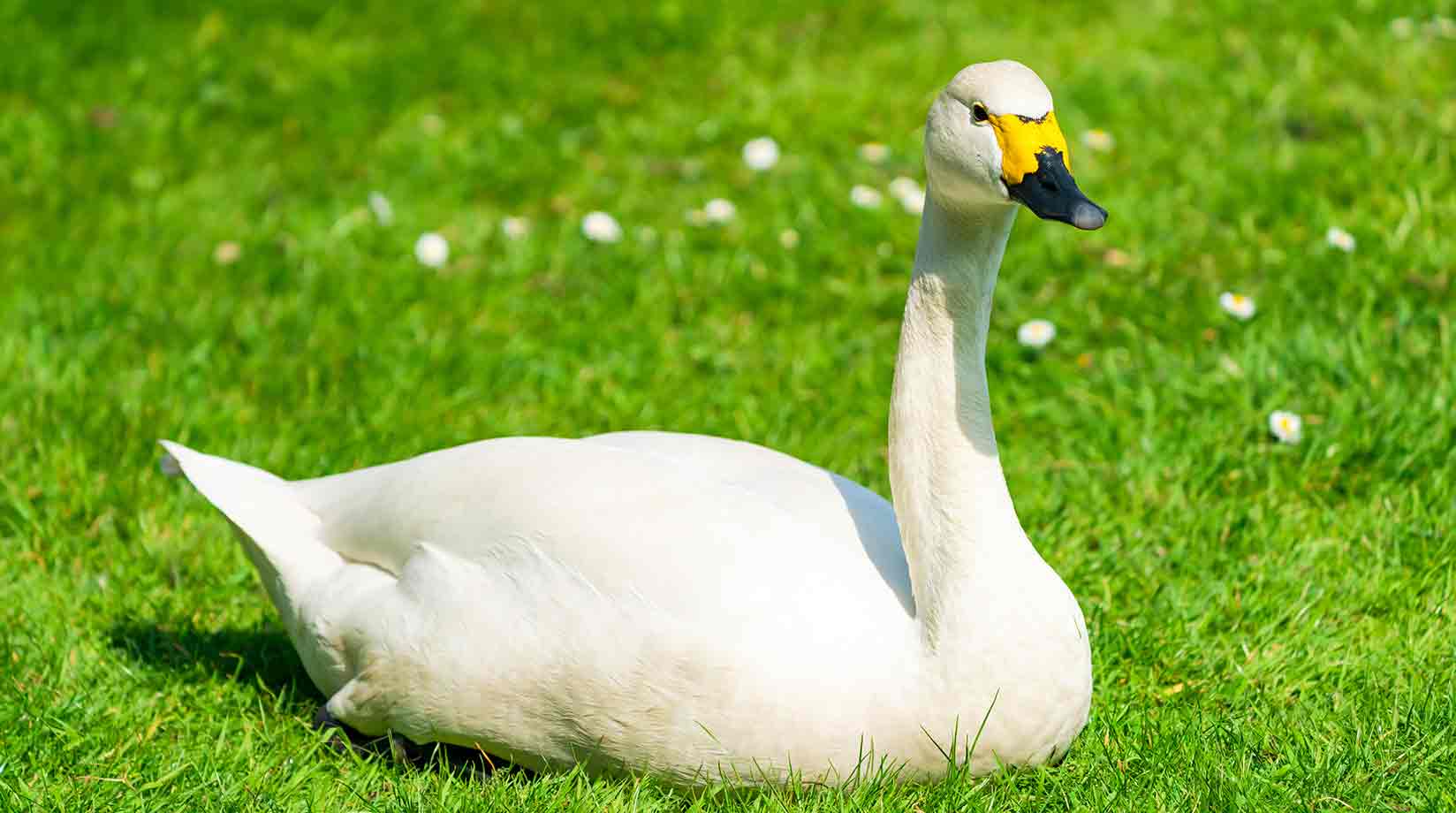
The sounds of waterfowl (such as ducks, geese and swans) are often compared to those made by double-reed wind instruments like the oboe, clarinet and bassoon However, swans can produce a much wider variety of noises: they can honk like a horn (or a trumpet), hiss like a cat and make rapid clicking sounds with their beak.
Adult swan pairs often develop unique vocalisations and are particularly vocal during their "triumph ceremonies", where they celebrate after a successful defence of their territory.53 Cygnets (baby swans), sound much less threatening, making high-pitched peeping sounds.54
While they may not honk quite as much as other species, the mute swan is not actually mute. In fact, mute swans make one of the most unique and distinctive sounds of any bird species. When they fly, their wingbeats make a heavy, wheezing sound like a dog panting after a run. This sound helps swans communicate during flight, helping the flock stay together, especially in foggy weather when visibility is poor.55
Swans’ elongated windpipes are useful for more than just creating an elegant silhouette – they may also help to amplify sound.56 Some birds in the Anatidae family, including the trumpeter swan, have loops in their tracheas making them longer and allowing the bird to make a much louder sound than its body size would suggest.57 Living up to its name, the trumpeter swan sounds like an army bugle, albeit a badly-played one. The coscoroba swan makes a call that sounds like its name (“cos-cor-roo”) and flying tundra swans make a “kow-hooo” sound.58 Black-necked swans produce a musical, airy whistle, which is relatively quiet compared to other species.59
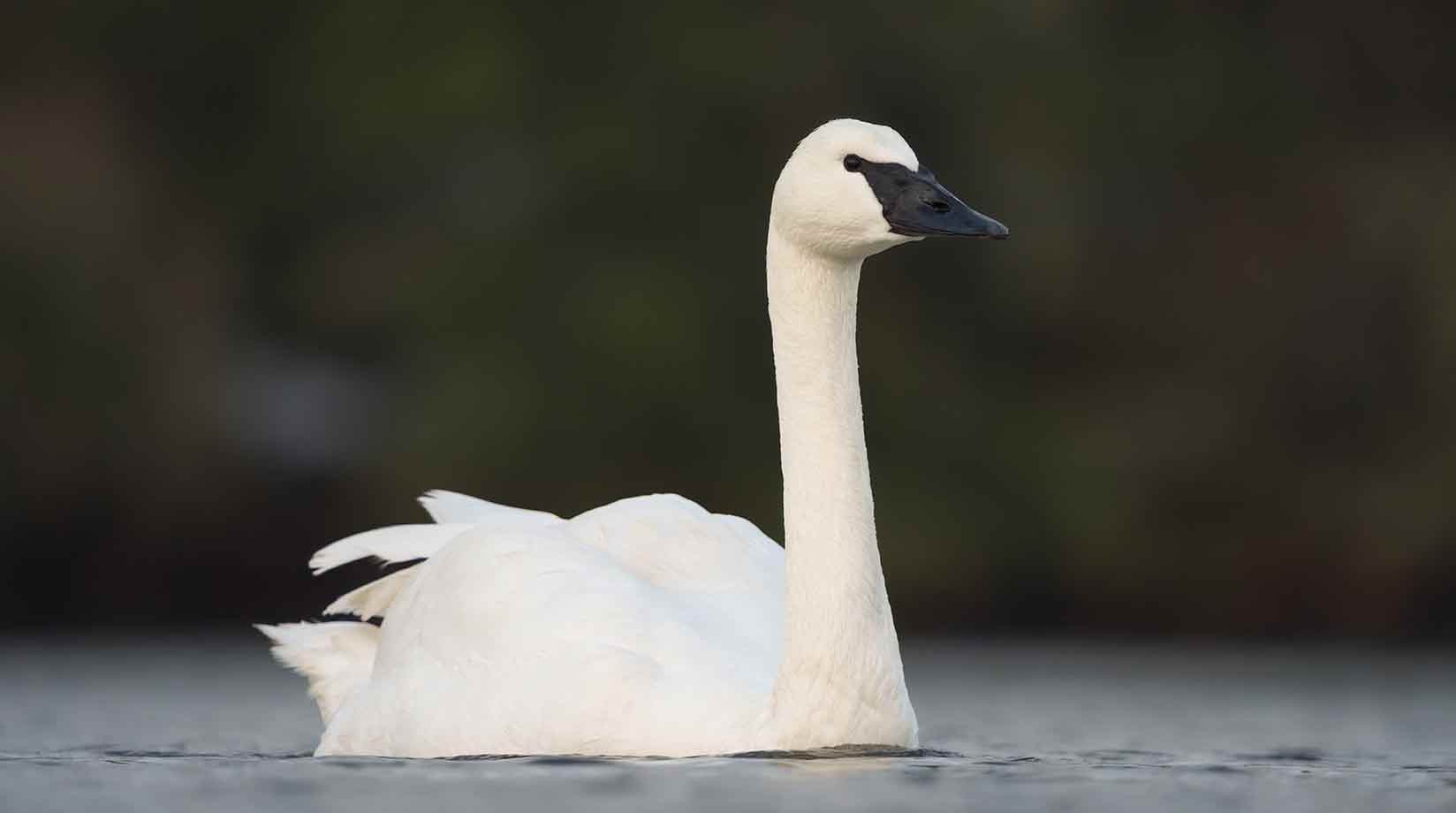
Swan eggs typically take 30-42 days to hatch, depending on the species. During this period, the female (called the pen) incubates the eggs, and will often turn them over with her beak to ensure even heating. During this time, the male swan (called the cob) stays close by, protecting the nest like a fierce and loyal guard dog. This protection job is crucial. Unlike other waterfowl, female swans are not well-camouflaged, making her (and her eggs) an easy target for predators.60
Pens lay 5-8 eggs on average in a nest made of soft vegetation, leaves and grasses, usually at the edge of still, shallow water. Mute swan nests can measure up to 2 to 3m wide.61 The nest of a mute swan is co-built by the parents and is typically made of twigs and soft vegetation. During incubation, a female mute swan may lose up to a third of her body weight.62
Squirrels, muskrats, foxes, birds of prey and other small predators will target swan eggs. However, the biggest threat to swan nests is human disturbance or destruction.63
Young cygnets hatch covered in fluffy grey down and, like other waterfowl, immediately imprint on the mother. Swans are "precocial", meaning that once they hatch, cygnets can walk and leave the nest almost instantly. Within 48 hours, cygnets are usually taken on their first swimming lesson.64
Featured image © Kovtun-Hydrobio | Shutterstock
Fun fact image © Mummabear | Shutterstock
Quick Facts:
1. “Swans: Overview.” International Fund for Animal Welfare. Accessed 6 Sept 2024. https://www.ifaw.org/uk/animals/swans#:~:text=Yes,%20swans%20mate%20for….
Fact File:
1. Nicolaides, Mark. “Key Facts About Swans.” Swan Life. Accessed 6 Sept 2024. https://www.swanlife.com/key-fact-about-swans.
2. Johnsgard, Paul. 2016. “Swans: Their Biology and Natural History.” Zea Books, Lincoln, Nebraska: University of Nebraska-Lincoln Libraries; University of Copenhagen. 2009. “World’s Oldest Swan Found Dead in Denmark.” Accessed 6 Sept 2024. www.sciencedaily.com/releases/2009/02/090213115129.htm.
3. “Cygnus.” IUCN Red List. Accessed 30 Sept 2024. https://www.iucnredlist.org/search?query=cygnus&searchType=species; Newth, Julia. “Swan Champions of the Russian Arctic.” Wildfowl and Wetlands Trust. Accessed 6 Sept 2024. https://www.wwt.org.uk/our-work/projects/swan-champions/
4. Goodison, Natalie Jayne. 2022. “Introducing the Medieval Swan.” United Kingdom: University of Wales Press; “The Swans.” Swan Specialist Group. Wetlands International: IUCN SSC. Accessed 6 Sept 2024. https://swansg.org/the-swans/.
5. “Black Swan FAQs.” The University of Melbourne. Accessed 6 Sept 2024. https://myswan.science.unimelb.edu.au/black-swans/#:~:text=Do%20black%2….
6. “Frequently Asked Questions.” Swan Lifeline. Accessed 30 Sept 2024. https://swanlifeline.uk/faqs#:~:text=What%20length%20does%20a%20mute,to….
7. Price, Alice L. 1994. “Swans of the world : in nature, history, myth & art.” Tulsa: Council Oak Books.
8. Price, Alice L. 1994. “Swans of the world : in nature, history, myth & art.” Tulsa: Council Oak Books; Nicolaides, Mark. “The Biology of Swans.” Swan Life. Accessed 6 Sept 2024. https://www.swanlife.com/biolo.
9. Goodison, Natalie Jayne. 2022. “Introducing the Medieval Swan.” United Kingdom: University of Wales Press.
10. Harms, Tyler M. Dinsmore, Stephen J. “Probable molt migration of a wild Trumpeter Swan documented by GPS technology.” Swan Specialist Group. Wetlands International: IUCN SSC. Accessed 6 Sept 2024. https://swansg.org/2023/01/30/probable-molt-migration-of-a-wild-trumpet…;
11. “FAQs.” Ifaw. Accessed 30 Sept 2024. https://www.ifaw.org/uk/animals/swans#faqs.
12. Nicolaides, Mark. “The Biology of Swans.” Swan Life. Accessed 6 Sept 2024. https://www.swanlife.com/biolo.
13. “Tundra Swan.” American Bird Conservancy. Accessed 6 Sept 2024. https://abcbirds.org/bird/tundra-swan/#:~:text=Each%20fall,%20Tundra%20…; Morris, Eric. 2022. “How High Do Airplanes Go?” Sheffield School of Aeronautics. Accessed 30 Sept 2024. https://www.sheffield.com/2022/how-high-do-airplanes-go.html.
14. Nicolaides, Mark. “Key Facts About Swans.” Swan Life. Accessed 6 Sept 2024. https://www.swanlife.com/key-fact-about-swans.
15. Nicolaides, Mark. “The Biology of Swans.” Swan Life. Accessed 6 Sept 2024. https://www.swanlife.com/biolo.
16. Price, Alice L. 1994. “Swans of the world : in nature, history, myth & art.” Tulsa: Council Oak Books.
17. Moss, Stephen. 2021. “The Swan: A Biography.” United Kingdom: Random House; Johnsgard, Paul. 2020. “The North American Swans: Their Biology and Conservation.” United States: University of Nebraska-Lincoln Libraries. “Species Factsheet: Whooper Swan Cygnus cygnus.” 2024. BirdLife International. Accessed 6 Sept 2024. https://datazone.birdlife.org/species/factsheet/whooper-swan-cygnus-cyg…;
18. “The Swans.” Swan Specialist Group. Wetlands International: IUCN SSC. Accessed 6 Sept 2024. https://swansg.org/the-swans/; Gumpenberger, Michaela. Scope, Alexander. 2012. “Computed tomography of coxofemoral injury in five mute swans (Cygnus olor).” Avian Pathology, 41 (5): 465. DOI: 10.1080/03079457.2012.712205.
19. “Swans.” 23 May 2018. Encyclopedia.com. Accessed 6 Sept 2024. https://www.encyclopedia.com/plants-and-animals/animals/vertebrate-zool…(C.
20. “The Swans.” Swan Specialist Group. Wetlands International: IUCN SSC. Accessed 6 Sept 2024. https://swansg.org/the-swans/.
21. “Species Factsheet: Whooper Swan Cygnus cygnus.” 2024. BirdLife International. Accessed 6 Sept 2024. https://datazone.birdlife.org/species/factsheet/whooper-swan-cygnus-cyg…; “Species Factsheet: Mute Swan Cygnus olor.” 2024. BirdLife International. Accessed 6 Sept 2024. https://datazone.birdlife.org/species/factsheet/mute-swan-cygnus-olor; “Frequently Asked Questions (FAQs).” The Swan Sanctuary. Accessed 6 Sept 2024. https://www.theswansanctuary.org.uk/general-information/; “The Swans.” Swan Specialist Group. Wetlands International: IUCN SSC. Accessed 6 Sept 2024. https://swansg.org/the-swans/.
22. Nicolaides, Mark. “What To Feed Swans?” Swan Life. Accessed 6 Sept 2024. https://www.swanlife.com/what-to-feed-swans; “Coscoroba Swan.” Swan Specialist Group. Wetlands International: IUCN SSC. Accessed 6 Sept 2024. https://swansg.org/the-swans/coscoroba/.
23. Nicolaides, Mark. “What do Swans Eat and Drink?” Swan Life. Accessed 6 Sept 2024. https://www.swanlife.com/what-swans-eat-and-drink; Nicolaides, Mark. “The Biology of Swans.” Swan Life. Accessed 6 Sept 2024. https://www.swanlife.com/biolo; “The Swans.” Swan Specialist Group. Wetlands International: IUCN SSC. Accessed 6 Sept 2024. https://swansg.org/the-swans/.
24. “Species Factsheet: Mute Swan Cygnus olor.” 2024. BirdLife International. Accessed 6 Sept 2024. https://datazone.birdlife.org/species/factsheet/mute-swan-cygnus-olor.
25. “Swans: Overview.” International Fund for Animal Welfare. Accessed 6 Sept 2024. https://www.ifaw.org/uk/animals/swans#:~:text=Yes,%20swans%20mate%20for….
26. “The Swans.” Swan Specialist Group. Wetlands International: IUCN SSC. Accessed 6 Sept 2024. https://swansg.org/the-swans/.
27. Nicolaides, Mark. “Swans Mate For Life” Swan Life. Accessed 6 Sept 2024. https://www.swanlife.com/swans-mate-for-life.
28. University Of Melbourne. 2006. ”Secret Sex Lives Of Swans Under Scrutiny In New Study." Accessed 6 Sept 2024.
29. Nicolaides, Mark. “What To Feed Swans?” Swan Life. Accessed 6 Sept 2024. https://www.swanlife.com/what-to-feed-swans; Nicolaides, Mark. “Swans After Leaving Their Parents” Swan Life. Accessed 30 Sept 2024. https://www.swanlife.com/swans-leaving-parents.
30. Johnsgard, Paul. 2016. “Swans: Their Biology and Natural History.” Zea Books, Lincoln, Nebraska: University of Nebraska-Lincoln Libraries.
31. “Black Swan FAQs.” The University of Melbourne. Accessed 6 Sept 2024. https://myswan.science.unimelb.edu.au/black-swans/#:~:text=Do%20black%2….
32. “Black Swan FAQs.” The University of Melbourne. Accessed 6 Sept 2024. https://myswan.science.unimelb.edu.au/black-swans/#:~:text=Do%20black%2…; Moss, Stephen. 2021. “The Swan: A Biography.” United Kingdom: Random House.
33. “The Swans.” Swan Specialist Group. Wetlands International: IUCN SSC. Accessed 6 Sept 2024. https://swansg.org/the-swans/.
34. “The Swans.” Swan Specialist Group. Wetlands International: IUCN SSC. Accessed 6 Sept 2024. https://swansg.org/the-swans/; Johnsgard, Paul. 2020. “The North American Swans: Their Biology and Conservation.” United States: University of Nebraska-Lincoln Libraries.
35. “Mute Swan: Cygnus olor (Gmelin, 1789).” Swan Specialist Group. Wetlands International: IUCN SSC. Accessed 6 Sept 2024. https://swansg.org/the-swans/mute/.
36. Nicolaides, Mark. “What do Swans Eat and Drink?” Swan Life. Accessed 6 Sept 2024. https://www.swanlife.com/what-swans-eat-and-drink.
37. “Black Swan: Cygnus atratus (Latham, 1790).” Swan Specialist Group. Wetlands International: IUCN SSC. Accessed 6 Sept 2024.https://swansg.org/the-swans/black-swan/.
38. Nicolaides, Mark. “Key Facts About Swans.” Swan Life. Accessed 6 Sept 2024. https://www.swanlife.com/key-fact-about-swans.
39. “Black Swan: Cygnus atratus (Latham, 1790).” Swan Specialist Group. Wetlands International: IUCN SSC. Accessed 6 Sept 2024.https://swansg.org/the-swans/black-swan/.
40. Haworth, David. 2021. “Friday essay: a rare bird — how Europeans got the black swan so wrong.” The Conversation. Accessed 30 Sept 2024. https://theconversation.com/friday-essay-a-rare-bird-how-europeans-got-…;
41. “Black Swan FAQs.” The University of Melbourne. Accessed 6 Sept 2024. https://myswan.science.unimelb.edu.au/black-swans/#:~:text=Do%20black%2….
42. Moss, Stephen. 2021. “The Swan: A Biography.” United Kingdom: Random House.
43. “The Swans.” Swan Specialist Group. Wetlands International: IUCN SSC. Accessed 6 Sept 2024. https://swansg.org/the-swans/.
44. “Species Factsheet: Whooper Swan Cygnus cygnus.” 2024. BirdLife International. Accessed 6 Sept 2024. https://datazone.birdlife.org/species/factsheet/whooper-swan-cygnus-cyg….
45. Johnsgard, Paul. 2020. “The North American Swans: Their Biology and Conservation.” United States: University of Nebraska-Lincoln Libraries.
46. “Whooper Swan: Cygnus cygnus (Linnaeus 1758).” Swan Specialist Group. Wetlands International: IUCN SSC. Accessed 6 Sept 2024. https://swansg.org/the-swans/whooper/.
47. “Tundra Swan.” American Bird Conservancy. Accessed 6 Sept 2024. https://abcbirds.org/bird/tundra-swan/#:~:text=Each%20fall,%20Tundra%20…;
48. “The Swans.” Swan Specialist Group. Wetlands International: IUCN SSC. Accessed 6 Sept 2024. https://swansg.org/the-swans/.
49. “Frequently Asked Questions (FAQs).” The Swan Sanctuary. Accessed 6 Sept 2024. https://www.theswansanctuary.org.uk/general-information/.
50. “Species Factsheet: Black Swan Cygnus atratus.” 2024. BirdLife International. Accessed 6 Sept 2024. https://datazone.birdlife.org/species/factsheet/black-swan-cygnus-atrat….
51. Newth, Julia. “Swan Champions of the Russian Arctic.” Wildfowl and Wetlands Trust. Accessed 6 Sept 2024. https://www.wwt.org.uk/our-work/projects/swan-champions/;“Monitoring Bewick’s Swan.” The Wildfowl and Wetlands Trust. Accessed 6 Sept 2024. https://www.wwt.org.uk/our-work/projects/bewicks-swans/#:~:text=Every%2….
52. Jia, Ru et al. “Migration routes of mute swans (Cygnus olor) in East Asia: First description of the Eastern and Western Chinese populations based on satellite tracking.” Swan Specialist Group. Wetlands International: IUCN SSC. Accessed 6 Sept 2024. https://swansg.org/2024/05/15/first-description-of-migration-routes-of-…;
53. Johnsgard, Paul. 2016. “Swans: Their Biology and Natural History.” Zea Books, Lincoln, Nebraska: University of Nebraska-Lincoln Libraries.
54. “The Swans.” Swan Specialist Group. Wetlands International: IUCN SSC. Accessed 6 Sept 2024. https://swansg.org/the-swans/
55. Johnsgard, Paul. 2020. “The North American Swans: Their Biology and Conservation.” United States: University of Nebraska-Lincoln Libraies.
56. Johnsgard, Paul. 2016. “Swans: Their Biology and Natural History.” Zea Books, Lincoln, Nebraska: University of Nebraska-Lincoln Libraries.
57. Goodison, Natalie Jayne. 2022. “Introducing the Medieval Swan.” United Kingdom: University of Wales Press; Johnsgard, Paul A. 1971. “Observations on sound production in the Anatidae.” Wildfowl Journal. 22. Accessed 29 Sept 2024. https://wildfowl.wwt.org.uk/index.php/wildfowl/article/view/420/420; Whitfield, John. 1999. “Heard but not seen.” Nature Evolution. 399(24). Accessed 29 Sept 2024. https://www.nature.com/articles/19873.
58. “Tundra Swan.” American Bird Conservancy. Accessed 6 Sept 2024. https://abcbirds.org/bird/tundra-swan/#:~:text=Each%20fall,%20Tundra%20…; Nicolaides, Mark. “What do Swans Eat and Drink?” Swan Life. Accessed 6 Sept 2024. https://www.swanlife.com/what-swans-eat-and-drink.
59. “Black Swan: Cygnus atratus (Latham, 1790).” Swan Specialist Group. Wetlands International: IUCN SSC. Accessed 6 Sept 2024.https://swansg.org/the-swans/black-swan/.
60. “Everything you need to know about mute swans.” Scottish Wildlife Trust. Accessed 29 Sept. 2024. https://scottishwildlifetrust.org.uk/2020/04/mute-swans/#:~:text=She%20…; Price, Alice L. 1994. “Swans of the world: in nature, history, myth & art.” Tulsa: Council Oak Books; “Swans.” 23 May 2018. Encyclopedia.com. Accessed 6 Sept 2024. https://www.encyclopedia.com/plants-and-animals/animals/vertebrate-zool…(C.
61. Goodison, Natalie Jayne. 2022. “Introducing the Medieval Swan.” United Kingdom: University of Wales Press; Price, Alice L. 1994. “Swans of the world : in nature, history, myth & art.” Tulsa: Council Oak Books; Nicolaides, Mark. “Where Do Swans Nest?” Swan Life. Accessed 6 Sept 2024. https://www.swanlife.com/the-nest.
62. Nicolaides, Mark. “What To Feed Swans?” Swan Life. Accessed 6 Sept 2024. https://www.swanlife.com/what-to-feed-swans.
63. Price, Alice L. 1994. “Swans of the world : in nature, history, myth & art.” Tulsa: Council Oak Books; Johnsgard, Paul. 2020. “The North American Swans: Their Biology and Conservation.” United States: University of Nebraska-Lincoln Libraries.
64. Price, Alice L. 1994. “Swans of the world : in nature, history, myth & art.” Tulsa: Council Oak Books.
In popular culture, swans are renowned for their beauty, grace and loyalty. But they are also highly territorial, and rather noisy. These large waterfowl are found in wetlands across all continents except Antarctica.
Cygnet
Flock, Wedge, Fanfare, Bevy
Aquatic vegetation, crops, molluscs, insects, crustaceans, small amphibians
Foxes may hunt adult swans, while squirrels, birds of prey, mink and rats will prey on cygnets or steal swan eggs
3-20 years in the wild, and up to 30 or 40 years in a protected environment
The body length of swans is between 1m to 1.7m depending on species.1 The average wingspan is 2.23m, but the widest, Trumpeter swans, can reach up to a 3m. That’s longer than most dining tables
Swans can weigh between 3.2kg which is barely more than a large bag of flour, and 22.7kg which is about the weight of a medium-sized dog
Swans are found on all continents except Antarctica
1.6 million
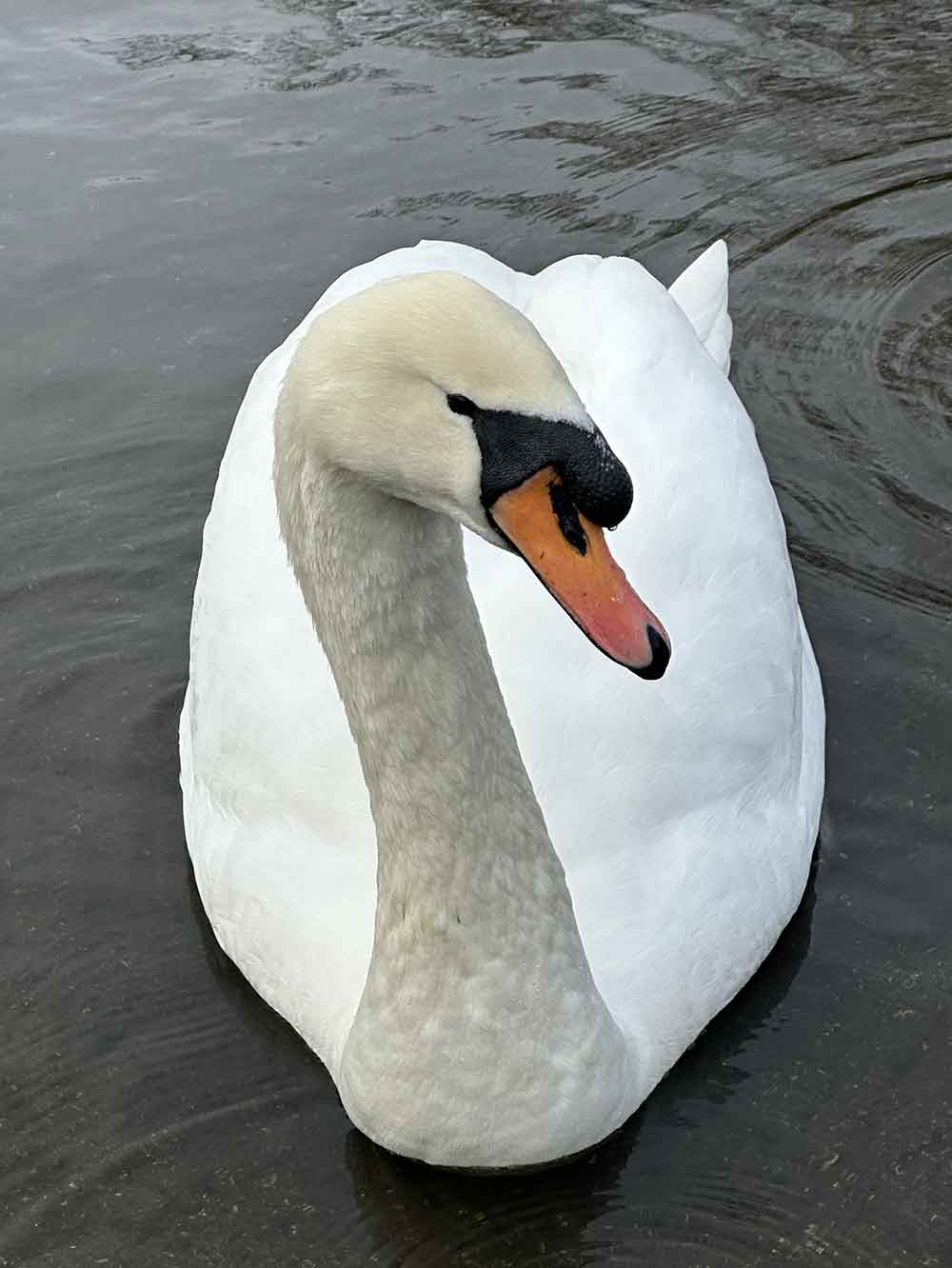
Swans have relatively long lifespans for birds. The oldest recorded wild swan was a 40-year-old mute swan in Denmark.
The swan's elegant posture, elongated neck and loyal pairing have endeared it to many cultures across the world. Swans belong to the waterfowl family, along with ducks and geese. They are excellent fliers, and many species migrate across international boundaries to breed. Their leathery, paddle-like feet make them efficient swimmers, although on land many have an awkward waddle. All swan species have distinctive, elongated necks, with mute swans forming an especially exaggerated ’S' shape. Two swans dipping their heads together to form a heart shape is an iconic and romantic image, but their long necks can just as easily lunge forwards to snap at any animal that ventures too close.
Swans are excellent fliers and some of the largest bird species capable of flight. Some species migrate long distances to breed and are among the fastest birds in the waterfowl family. The flight speed of swans can reach up to 96 km (60mph).11 Like many birds, swans have hollow bones to aid flight and buoyancy, and they have fewer bones relative to their size than mammals and reptiles.12 When migrating, swans typically fly in a distinctive V formation at different altitudes; Tundra swans fly at heights of up to 7,925m. For comparison, commercial aircraft generally cruise at 10,000 – 12,000m.13 Swans are also one of the heaviest birds to fly, though the heaviest record-holder is the great bustard.14
A swan has around 25,000 feathers in total, most of which are the tiny ones around its head and neck.15 Their outer feathers, called pennae, are essential for flight; if more than four of these feathers are clipped or damaged, the swan can become grounded. Once a year, swans moult and lose all their flight feathers, grounding them for around six weeks until the feathers regrow.16 While they are capable fliers, swans are unfortunately very accident prone and mid-air collisions with overhead wires, wind turbines and other objects are a major cause of death.17 Other threats include lead poisoning, avian flu, oil spills, illegal hunting and even breaking a hip during crash landings.18

Swans primarily eat aquatic vegetation. They tip their bodies forwards (upend) to plunge their heads and elongated necks underwater to search for food.19
During winter, some swan species eat crops like cereals and potatoes to supplement their diet.20 Swans will also eat small invertebrates, tiny fish, tadpoles, worms, molluscs and small amphibians though vegetation makes up most of their diet. Cygnets eat insects, crustaceans and other small invertebrates for protein.21 If you wanted to feed a swan, you could feed them rolled oats and even bread as long as its fresh (although, you should avoid feeding bread to other bird species), and you should also avoid feeding nesting swans as it can attract vermin.22
Swans do not have teeth, but their bills have serrated edges to filter food from the mud. Like other birds, they have a gizzard (a muscular organ and second part of the stomach) that grinds down hard food like wheat. Swans also use their feet to expose vegetation.23

Swans typically drink freshwater but can on occasion drink seawater. Many duck and swan species have a gland near their eyes to extract and remove salt from their blood, which is excreted through holes in the bill called nares.24
Swans usually mate for life and raise multiple broods together.25 They perform unique rituals to identify each other and strengthen their bond. Scientists even think that forming a strong, monogamous bond makes the swan pair better parents, as they are able to learn and improve co-parenting skills together.26 Occasionally, swan pairs may separate, but this is usually after a breeding failure such as unhatched eggs or a destroyed nest. In these instances the bird usually forms another pair, sometimes within six months.27 Black swans are less monogamous: one study found that one in six baby Black swans are fathered by a male outside the swan parental pair.28

Very close bonds are formed between the parental swan pair and their offspring, and cygnets typically stay with the parents for between five and 10 months. However, after this period, the parents often chase their offspring away.29
Swan pair rituals include pre- and post-nuptial displays before and after they mate, as well as some swans performing "triumph ceremonies", where the pair appears to celebrate together after chasing away a threat or winning an aggressive encounter.30 Their rituals can involve swimming in synchrony, dipping their heads into the water, swinging their necks side to side, or bowing heads together to form the iconic heart shape. But not all heart-shaped displays are between pairs; male swans can form the same shape during aggressive stand-offs.31
The idea that a swan can easily break a human’s arm is exaggerated, but it is true that a swan’s wing is capable of causing injury. Swans have very powerful wings; they have a hard carpal bone at the join of their wings which could cause a nasty bruise to a human if they were hit with force by a swan. Young children and elderly people may be more at risk since they have weaker bones. Cases of swans attacking humans are extremely rare, but humans may be most at risk of being injured by a swan which is defending its nest or young. Typically, a swan aims only to chase away, not harm, other swans, geese or threats by beating their wings.32

There are six to eight species of swan, depending on how they are classified. The mute swan, whooper swan, trumpeter swan, and tundra swans (Bewick’s swan and the whistling swan) are native to the northern hemisphere. The black swan, black-necked swan and coscoroba swan are native to the southern hemisphere.33 All swans have all-white plumage, except the black and black-necked swans. Beak colours can vary from yellow, orange, black, pink or red, depending on the species.
The whistling swan and Bewick’s swan are often classified as different populations of the tundra swan rather than separate species.34 The whistling swan is native to Eurasia while Bewick’s swan is native to North America. Both are white with black beaks, but Bewick’s swans have a yellow patch at the base of their beak. The mute swan is perhaps the most iconic and recognisable swan species. It has immaculate all-white plumage, an orange beak, upright posture, a dramatically curved neck and a tendency to arch its wings backwards. Mute swans are usually cited as the largest species, at around 1.4-1.6m long and 9.7-11.9kg.35 But trumpeter swans can grow even heavier, reaching up to 14kg.
The coscoroba swan, native to south America, is the smallest species at around 0.9-1.15m. It is no longer considered a true swan in the Cygnus genus and is instead assigned to the genus Coscorba. Scientists found that the coscoroba swan is more closely related to the Cape Barren Goose than to other swan species. It is all-white, has a short neck, a rounded head and a red bill.36
The black swan is not at all rare. Like other species of swan it is classified as Least Concern by the International Union for Conservation of Nature, meaning its population is stable.37 It is native to Australia, where they are widespread, black swans have also been introduced to New Zealand and there are vagrant populations in Papa New Guinea.38 In Australia, the black swan population is estimated to range from 100,000 to 1,000,000 individuals. When swimming, black swans appear completely black, with a red or dark orange beak featuring a distinctive white strip across the tip. Surprisingly, black swans are not entirely black. When in flight, they reveal their white wingtips, which are normally tucked away.39 Before Europeans travelled to Australia, the phrase ‘black swan’ was already used to describe something unbelievable, as only white swans existed in the northern hemisphere.40 When the European explorer Willem de Vlamingh spotted black swans in the late 1600s in Australia, people back in Europe refused to believe the bird existed until de Vlamingh sent specimens back.41 The modern use of the phrase ‘black swan’ often refers to a unprecedented socioeconomic event or natural disaster which cannot be foreseen.42

Most swans migrate. They have specific areas, countries or continents where they spend winter, and will typically migrate to different parts of the world during spring and summer to breed. Whooper, tundra and trumpeter swans are fully migratory, travelling long distances between summer and winter breeding grounds.43 Swans can migrate in small flocks and family groups or congregate in flocks of around 300-400.44
Each species has several populations, each with unique breeding grounds and migration routes.45 For example, there are five main populations of whooper swans, all with different migratory paths across Eurasia.46 Swans’ migratory ranges vary extensively depending on species and population group: Tundra swans can migrate for distances up to 6,500 km.47
Mute swans and black-necked swans are partially migratory, meaning only some populations migrate overseas, while others stay in the same area year-round.48 Truly wild populations of this species are migratory (particularly where displaced by cold weather) although European and feral populations are essentially sedentary or only locally migratory.49 Black swans are considered resident birds, meaning they live in Australia and New Zealand and do not migrate, although they have been introduced to Papua New Guinea.50
In autumn, some populations of Bewick’s swan migrate 3,500km from northern Russia to the UK, the Netherlands, Denmark and Germany to escape the harsh Arctic winter, and return to Russia in spring to breed. These journeys are dangerous. There are few wetlands along the way for resting, and the swans are also at risk of flying into power lines or being illegally poached.51

The sounds of waterfowl (such as ducks, geese and swans) are often compared to those made by double-reed wind instruments like the oboe, clarinet and bassoon However, swans can produce a much wider variety of noises: they can honk like a horn (or a trumpet), hiss like a cat and make rapid clicking sounds with their beak.
Adult swan pairs often develop unique vocalisations and are particularly vocal during their "triumph ceremonies", where they celebrate after a successful defence of their territory.53 Cygnets (baby swans), sound much less threatening, making high-pitched peeping sounds.54
While they may not honk quite as much as other species, the mute swan is not actually mute. In fact, mute swans make one of the most unique and distinctive sounds of any bird species. When they fly, their wingbeats make a heavy, wheezing sound like a dog panting after a run. This sound helps swans communicate during flight, helping the flock stay together, especially in foggy weather when visibility is poor.55
Swans’ elongated windpipes are useful for more than just creating an elegant silhouette – they may also help to amplify sound.56 Some birds in the Anatidae family, including the trumpeter swan, have loops in their tracheas making them longer and allowing the bird to make a much louder sound than its body size would suggest.57 Living up to its name, the trumpeter swan sounds like an army bugle, albeit a badly-played one. The coscoroba swan makes a call that sounds like its name (“cos-cor-roo”) and flying tundra swans make a “kow-hooo” sound.58 Black-necked swans produce a musical, airy whistle, which is relatively quiet compared to other species.59

Swan eggs typically take 30-42 days to hatch, depending on the species. During this period, the female (called the pen) incubates the eggs, and will often turn them over with her beak to ensure even heating. During this time, the male swan (called the cob) stays close by, protecting the nest like a fierce and loyal guard dog. This protection job is crucial. Unlike other waterfowl, female swans are not well-camouflaged, making her (and her eggs) an easy target for predators.60
Pens lay 5-8 eggs on average in a nest made of soft vegetation, leaves and grasses, usually at the edge of still, shallow water. Mute swan nests can measure up to 2 to 3m wide.61 The nest of a mute swan is co-built by the parents and is typically made of twigs and soft vegetation. During incubation, a female mute swan may lose up to a third of her body weight.62
Squirrels, muskrats, foxes, birds of prey and other small predators will target swan eggs. However, the biggest threat to swan nests is human disturbance or destruction.63
Young cygnets hatch covered in fluffy grey down and, like other waterfowl, immediately imprint on the mother. Swans are "precocial", meaning that once they hatch, cygnets can walk and leave the nest almost instantly. Within 48 hours, cygnets are usually taken on their first swimming lesson.64
Featured image © Kovtun-Hydrobio | Shutterstock
Fun fact image © Mummabear | Shutterstock
Quick Facts:
1. “Swans: Overview.” International Fund for Animal Welfare. Accessed 6 Sept 2024. https://www.ifaw.org/uk/animals/swans#:~:text=Yes,%20swans%20mate%20for….
Fact File:
1. Nicolaides, Mark. “Key Facts About Swans.” Swan Life. Accessed 6 Sept 2024. https://www.swanlife.com/key-fact-about-swans.
2. Johnsgard, Paul. 2016. “Swans: Their Biology and Natural History.” Zea Books, Lincoln, Nebraska: University of Nebraska-Lincoln Libraries; University of Copenhagen. 2009. “World’s Oldest Swan Found Dead in Denmark.” Accessed 6 Sept 2024. www.sciencedaily.com/releases/2009/02/090213115129.htm.
3. “Cygnus.” IUCN Red List. Accessed 30 Sept 2024. https://www.iucnredlist.org/search?query=cygnus&searchType=species; Newth, Julia. “Swan Champions of the Russian Arctic.” Wildfowl and Wetlands Trust. Accessed 6 Sept 2024. https://www.wwt.org.uk/our-work/projects/swan-champions/
4. Goodison, Natalie Jayne. 2022. “Introducing the Medieval Swan.” United Kingdom: University of Wales Press; “The Swans.” Swan Specialist Group. Wetlands International: IUCN SSC. Accessed 6 Sept 2024. https://swansg.org/the-swans/.
5. “Black Swan FAQs.” The University of Melbourne. Accessed 6 Sept 2024. https://myswan.science.unimelb.edu.au/black-swans/#:~:text=Do%20black%2….
6. “Frequently Asked Questions.” Swan Lifeline. Accessed 30 Sept 2024. https://swanlifeline.uk/faqs#:~:text=What%20length%20does%20a%20mute,to….
7. Price, Alice L. 1994. “Swans of the world : in nature, history, myth & art.” Tulsa: Council Oak Books.
8. Price, Alice L. 1994. “Swans of the world : in nature, history, myth & art.” Tulsa: Council Oak Books; Nicolaides, Mark. “The Biology of Swans.” Swan Life. Accessed 6 Sept 2024. https://www.swanlife.com/biolo.
9. Goodison, Natalie Jayne. 2022. “Introducing the Medieval Swan.” United Kingdom: University of Wales Press.
10. Harms, Tyler M. Dinsmore, Stephen J. “Probable molt migration of a wild Trumpeter Swan documented by GPS technology.” Swan Specialist Group. Wetlands International: IUCN SSC. Accessed 6 Sept 2024. https://swansg.org/2023/01/30/probable-molt-migration-of-a-wild-trumpet…;
11. “FAQs.” Ifaw. Accessed 30 Sept 2024. https://www.ifaw.org/uk/animals/swans#faqs.
12. Nicolaides, Mark. “The Biology of Swans.” Swan Life. Accessed 6 Sept 2024. https://www.swanlife.com/biolo.
13. “Tundra Swan.” American Bird Conservancy. Accessed 6 Sept 2024. https://abcbirds.org/bird/tundra-swan/#:~:text=Each%20fall,%20Tundra%20…; Morris, Eric. 2022. “How High Do Airplanes Go?” Sheffield School of Aeronautics. Accessed 30 Sept 2024. https://www.sheffield.com/2022/how-high-do-airplanes-go.html.
14. Nicolaides, Mark. “Key Facts About Swans.” Swan Life. Accessed 6 Sept 2024. https://www.swanlife.com/key-fact-about-swans.
15. Nicolaides, Mark. “The Biology of Swans.” Swan Life. Accessed 6 Sept 2024. https://www.swanlife.com/biolo.
16. Price, Alice L. 1994. “Swans of the world : in nature, history, myth & art.” Tulsa: Council Oak Books.
17. Moss, Stephen. 2021. “The Swan: A Biography.” United Kingdom: Random House; Johnsgard, Paul. 2020. “The North American Swans: Their Biology and Conservation.” United States: University of Nebraska-Lincoln Libraries. “Species Factsheet: Whooper Swan Cygnus cygnus.” 2024. BirdLife International. Accessed 6 Sept 2024. https://datazone.birdlife.org/species/factsheet/whooper-swan-cygnus-cyg…;
18. “The Swans.” Swan Specialist Group. Wetlands International: IUCN SSC. Accessed 6 Sept 2024. https://swansg.org/the-swans/; Gumpenberger, Michaela. Scope, Alexander. 2012. “Computed tomography of coxofemoral injury in five mute swans (Cygnus olor).” Avian Pathology, 41 (5): 465. DOI: 10.1080/03079457.2012.712205.
19. “Swans.” 23 May 2018. Encyclopedia.com. Accessed 6 Sept 2024. https://www.encyclopedia.com/plants-and-animals/animals/vertebrate-zool…(C.
20. “The Swans.” Swan Specialist Group. Wetlands International: IUCN SSC. Accessed 6 Sept 2024. https://swansg.org/the-swans/.
21. “Species Factsheet: Whooper Swan Cygnus cygnus.” 2024. BirdLife International. Accessed 6 Sept 2024. https://datazone.birdlife.org/species/factsheet/whooper-swan-cygnus-cyg…; “Species Factsheet: Mute Swan Cygnus olor.” 2024. BirdLife International. Accessed 6 Sept 2024. https://datazone.birdlife.org/species/factsheet/mute-swan-cygnus-olor; “Frequently Asked Questions (FAQs).” The Swan Sanctuary. Accessed 6 Sept 2024. https://www.theswansanctuary.org.uk/general-information/; “The Swans.” Swan Specialist Group. Wetlands International: IUCN SSC. Accessed 6 Sept 2024. https://swansg.org/the-swans/.
22. Nicolaides, Mark. “What To Feed Swans?” Swan Life. Accessed 6 Sept 2024. https://www.swanlife.com/what-to-feed-swans; “Coscoroba Swan.” Swan Specialist Group. Wetlands International: IUCN SSC. Accessed 6 Sept 2024. https://swansg.org/the-swans/coscoroba/.
23. Nicolaides, Mark. “What do Swans Eat and Drink?” Swan Life. Accessed 6 Sept 2024. https://www.swanlife.com/what-swans-eat-and-drink; Nicolaides, Mark. “The Biology of Swans.” Swan Life. Accessed 6 Sept 2024. https://www.swanlife.com/biolo; “The Swans.” Swan Specialist Group. Wetlands International: IUCN SSC. Accessed 6 Sept 2024. https://swansg.org/the-swans/.
24. “Species Factsheet: Mute Swan Cygnus olor.” 2024. BirdLife International. Accessed 6 Sept 2024. https://datazone.birdlife.org/species/factsheet/mute-swan-cygnus-olor.
25. “Swans: Overview.” International Fund for Animal Welfare. Accessed 6 Sept 2024. https://www.ifaw.org/uk/animals/swans#:~:text=Yes,%20swans%20mate%20for….
26. “The Swans.” Swan Specialist Group. Wetlands International: IUCN SSC. Accessed 6 Sept 2024. https://swansg.org/the-swans/.
27. Nicolaides, Mark. “Swans Mate For Life” Swan Life. Accessed 6 Sept 2024. https://www.swanlife.com/swans-mate-for-life.
28. University Of Melbourne. 2006. ”Secret Sex Lives Of Swans Under Scrutiny In New Study." Accessed 6 Sept 2024.
29. Nicolaides, Mark. “What To Feed Swans?” Swan Life. Accessed 6 Sept 2024. https://www.swanlife.com/what-to-feed-swans; Nicolaides, Mark. “Swans After Leaving Their Parents” Swan Life. Accessed 30 Sept 2024. https://www.swanlife.com/swans-leaving-parents.
30. Johnsgard, Paul. 2016. “Swans: Their Biology and Natural History.” Zea Books, Lincoln, Nebraska: University of Nebraska-Lincoln Libraries.
31. “Black Swan FAQs.” The University of Melbourne. Accessed 6 Sept 2024. https://myswan.science.unimelb.edu.au/black-swans/#:~:text=Do%20black%2….
32. “Black Swan FAQs.” The University of Melbourne. Accessed 6 Sept 2024. https://myswan.science.unimelb.edu.au/black-swans/#:~:text=Do%20black%2…; Moss, Stephen. 2021. “The Swan: A Biography.” United Kingdom: Random House.
33. “The Swans.” Swan Specialist Group. Wetlands International: IUCN SSC. Accessed 6 Sept 2024. https://swansg.org/the-swans/.
34. “The Swans.” Swan Specialist Group. Wetlands International: IUCN SSC. Accessed 6 Sept 2024. https://swansg.org/the-swans/; Johnsgard, Paul. 2020. “The North American Swans: Their Biology and Conservation.” United States: University of Nebraska-Lincoln Libraries.
35. “Mute Swan: Cygnus olor (Gmelin, 1789).” Swan Specialist Group. Wetlands International: IUCN SSC. Accessed 6 Sept 2024. https://swansg.org/the-swans/mute/.
36. Nicolaides, Mark. “What do Swans Eat and Drink?” Swan Life. Accessed 6 Sept 2024. https://www.swanlife.com/what-swans-eat-and-drink.
37. “Black Swan: Cygnus atratus (Latham, 1790).” Swan Specialist Group. Wetlands International: IUCN SSC. Accessed 6 Sept 2024.https://swansg.org/the-swans/black-swan/.
38. Nicolaides, Mark. “Key Facts About Swans.” Swan Life. Accessed 6 Sept 2024. https://www.swanlife.com/key-fact-about-swans.
39. “Black Swan: Cygnus atratus (Latham, 1790).” Swan Specialist Group. Wetlands International: IUCN SSC. Accessed 6 Sept 2024.https://swansg.org/the-swans/black-swan/.
40. Haworth, David. 2021. “Friday essay: a rare bird — how Europeans got the black swan so wrong.” The Conversation. Accessed 30 Sept 2024. https://theconversation.com/friday-essay-a-rare-bird-how-europeans-got-…;
41. “Black Swan FAQs.” The University of Melbourne. Accessed 6 Sept 2024. https://myswan.science.unimelb.edu.au/black-swans/#:~:text=Do%20black%2….
42. Moss, Stephen. 2021. “The Swan: A Biography.” United Kingdom: Random House.
43. “The Swans.” Swan Specialist Group. Wetlands International: IUCN SSC. Accessed 6 Sept 2024. https://swansg.org/the-swans/.
44. “Species Factsheet: Whooper Swan Cygnus cygnus.” 2024. BirdLife International. Accessed 6 Sept 2024. https://datazone.birdlife.org/species/factsheet/whooper-swan-cygnus-cyg….
45. Johnsgard, Paul. 2020. “The North American Swans: Their Biology and Conservation.” United States: University of Nebraska-Lincoln Libraries.
46. “Whooper Swan: Cygnus cygnus (Linnaeus 1758).” Swan Specialist Group. Wetlands International: IUCN SSC. Accessed 6 Sept 2024. https://swansg.org/the-swans/whooper/.
47. “Tundra Swan.” American Bird Conservancy. Accessed 6 Sept 2024. https://abcbirds.org/bird/tundra-swan/#:~:text=Each%20fall,%20Tundra%20…;
48. “The Swans.” Swan Specialist Group. Wetlands International: IUCN SSC. Accessed 6 Sept 2024. https://swansg.org/the-swans/.
49. “Frequently Asked Questions (FAQs).” The Swan Sanctuary. Accessed 6 Sept 2024. https://www.theswansanctuary.org.uk/general-information/.
50. “Species Factsheet: Black Swan Cygnus atratus.” 2024. BirdLife International. Accessed 6 Sept 2024. https://datazone.birdlife.org/species/factsheet/black-swan-cygnus-atrat….
51. Newth, Julia. “Swan Champions of the Russian Arctic.” Wildfowl and Wetlands Trust. Accessed 6 Sept 2024. https://www.wwt.org.uk/our-work/projects/swan-champions/;“Monitoring Bewick’s Swan.” The Wildfowl and Wetlands Trust. Accessed 6 Sept 2024. https://www.wwt.org.uk/our-work/projects/bewicks-swans/#:~:text=Every%2….
52. Jia, Ru et al. “Migration routes of mute swans (Cygnus olor) in East Asia: First description of the Eastern and Western Chinese populations based on satellite tracking.” Swan Specialist Group. Wetlands International: IUCN SSC. Accessed 6 Sept 2024. https://swansg.org/2024/05/15/first-description-of-migration-routes-of-…;
53. Johnsgard, Paul. 2016. “Swans: Their Biology and Natural History.” Zea Books, Lincoln, Nebraska: University of Nebraska-Lincoln Libraries.
54. “The Swans.” Swan Specialist Group. Wetlands International: IUCN SSC. Accessed 6 Sept 2024. https://swansg.org/the-swans/
55. Johnsgard, Paul. 2020. “The North American Swans: Their Biology and Conservation.” United States: University of Nebraska-Lincoln Libraies.
56. Johnsgard, Paul. 2016. “Swans: Their Biology and Natural History.” Zea Books, Lincoln, Nebraska: University of Nebraska-Lincoln Libraries.
57. Goodison, Natalie Jayne. 2022. “Introducing the Medieval Swan.” United Kingdom: University of Wales Press; Johnsgard, Paul A. 1971. “Observations on sound production in the Anatidae.” Wildfowl Journal. 22. Accessed 29 Sept 2024. https://wildfowl.wwt.org.uk/index.php/wildfowl/article/view/420/420; Whitfield, John. 1999. “Heard but not seen.” Nature Evolution. 399(24). Accessed 29 Sept 2024. https://www.nature.com/articles/19873.
58. “Tundra Swan.” American Bird Conservancy. Accessed 6 Sept 2024. https://abcbirds.org/bird/tundra-swan/#:~:text=Each%20fall,%20Tundra%20…; Nicolaides, Mark. “What do Swans Eat and Drink?” Swan Life. Accessed 6 Sept 2024. https://www.swanlife.com/what-swans-eat-and-drink.
59. “Black Swan: Cygnus atratus (Latham, 1790).” Swan Specialist Group. Wetlands International: IUCN SSC. Accessed 6 Sept 2024.https://swansg.org/the-swans/black-swan/.
60. “Everything you need to know about mute swans.” Scottish Wildlife Trust. Accessed 29 Sept. 2024. https://scottishwildlifetrust.org.uk/2020/04/mute-swans/#:~:text=She%20…; Price, Alice L. 1994. “Swans of the world: in nature, history, myth & art.” Tulsa: Council Oak Books; “Swans.” 23 May 2018. Encyclopedia.com. Accessed 6 Sept 2024. https://www.encyclopedia.com/plants-and-animals/animals/vertebrate-zool…(C.
61. Goodison, Natalie Jayne. 2022. “Introducing the Medieval Swan.” United Kingdom: University of Wales Press; Price, Alice L. 1994. “Swans of the world : in nature, history, myth & art.” Tulsa: Council Oak Books; Nicolaides, Mark. “Where Do Swans Nest?” Swan Life. Accessed 6 Sept 2024. https://www.swanlife.com/the-nest.
62. Nicolaides, Mark. “What To Feed Swans?” Swan Life. Accessed 6 Sept 2024. https://www.swanlife.com/what-to-feed-swans.
63. Price, Alice L. 1994. “Swans of the world : in nature, history, myth & art.” Tulsa: Council Oak Books; Johnsgard, Paul. 2020. “The North American Swans: Their Biology and Conservation.” United States: University of Nebraska-Lincoln Libraries.
64. Price, Alice L. 1994. “Swans of the world : in nature, history, myth & art.” Tulsa: Council Oak Books.
Cygnet
Flock, Wedge, Fanfare, Bevy
Aquatic vegetation, crops, molluscs, insects, crustaceans, small amphibians
Foxes may hunt adult swans, while squirrels, birds of prey, mink and rats will prey on cygnets or steal swan eggs
3-20 years in the wild, and up to 30 or 40 years in a protected environment
The body length of swans is between 1m to 1.7m depending on species.1 The average wingspan is 2.23m, but the widest, Trumpeter swans, can reach up to a 3m. That’s longer than most dining tables
Swans can weigh between 3.2kg which is barely more than a large bag of flour, and 22.7kg which is about the weight of a medium-sized dog
Swans are found on all continents except Antarctica
1.6 million

Swans have relatively long lifespans for birds. The oldest recorded wild swan was a 40-year-old mute swan in Denmark.